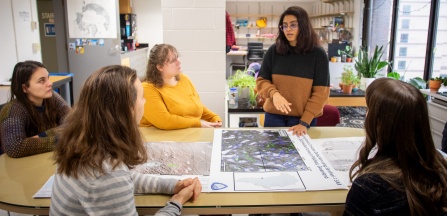Research Labs

The University at Buffalo Department of Earth Sciences stands out as a leader within the SUNY system, offering state-of-the-art facilities and pioneering research projects that push the boundaries of the field.
Learn more about:
The two Buffalo Undersea Research Labs, operated by the Ecology, Evolution and Behavior graduate program, focus primarily on coral reef-related projects. From studying coral reef genomes to reef connectivity, these labs are devoted to researching the intensely interesting and dynamic ecosystems within our waters.
The Geodynamics Research and Visualization Lab models the solid-state deformation of the lithosphere and upper mantle, with a focus on plate boundaries. This is accomplished through field work, analytic modeling, large-scale numerical modeling, data assimilation, and scientific data visualization. Research areas are slab-driven mantle flow dynamics, feedbacks between the slab and upper plate, and designing high-resolution 3D models of plate boundary systems. Besides pencil and paper for analytic problem formulation, the lab has (a) 1200-core Dell Linux Cluster, geosolver, shared with the Knepley Computational Science Group and (b) a custom-built 3D immersive virtual reality workspace in Cooke Hall.
The Paleoclimate Lab uses glacial and lacustrine records to study climate change in the Arctic. This group studies ice sheet processes and the history of glaciation to understand arctic climate change during the Pleistocene and the Holocene. The lab uses cosmogenic radionuclides to date glacial features and to understand basal ice sheet processes. They also employ standard paleolimnologic techniques on both organic and proglacial sediments to understand paleoenvironmental change on many timescales (last century, Holocene, late Pleistocene, earlier interglacials).
The Glacier Modeling Lab studies earth’s ice sheets, especially the Greenland Ice Sheet, as well as Antarctica, past ice sheets like the Laurentide, and glaciers worldwide. The research investigate ice flow and how liquid water changes it, and vice versa: how ice flow can affect the behavior of water on the surface, inside, or under the ice. How, when, and where does surface melt water get to the ice-sheet bed, and how does this affect ice dynamics? The Glacier Modeling Lab works with a number of different computer-based ice-sheet models, either existing models or ones written by lab members, and remote sensing data.
The Remote Sensing Lab uses remote sensing and geophysical to investigate the complex dynamics of the Earth's system and its interaction with the human environment. We aim to better understand ice flow processes and history by reconstructing glacier and ice sheet behavior from altimetry and other remote sensing observations. We combine geophysical, remote sensing, climate, and glaciological observations to understand the linkages between subglacial geology and ice sheet dynamics. We also develop and apply new algorithms for analyzing and fusing remote sensing and photogrammetry data and support new satellite missions, such as NASA's ICESat-2.
The Ice Sheet and Sea Level Lab uses a combination of tools that range from ice sheet and climate models, mathematics and remote sensed observations to study the Greenland and Antarctic ice sheets, their connections to the Earth’s climate system and their impact on sea level. The Lab uses a variety of existing models of different complexity to explore ice sheet processes and project their evolution under a changing climate.
The Organic and Stable Isotope Biogeochemistry Lab Applies state-of-the-art organic and stable isotope biogeochemistry analytical tools to address pressing questions regarding climate, environment, and water-related natural hazards. We have an Accelerated Solvent Extractor, a Gas Chromatograph with a Flame Ionization Detector, an Isotope Ratio Mass Spectrometer with Gas Chromatograph and Elemental Analyzer Peripherals, and a Cavity Ringdown Laser Spectrometer to measure stable isotopes in water. This lab is managed by a full-time technician. OSIBL is a UB Service Center, and a resource for all researchers within and outside the UB community.
The Physical Hydrogeology Lab focuses primarily on issues relating to the physical aspects of groundwater flow. Much of the work is conducted within wetland and riparian environments, investigating controls on groundwater flow and groundwater/stream interactions. An array of tools is used to investigate groundwater flow systems, with most projects using a combination of field work and numerical modeling.
Volcanology Lab
Our volcanology lab has capabilities for a range of experiments. Recent work analog studies of lava flows and volcano-tectonic interactions, and heat transfer studies between molten volcanic materials and air and water. Grain size and component analysis, along with petrographic studies can be done in the lab as well. The Geohazards Field Station (managed by the Center for Geohazards Studies) provides a unique facility for large-scale experiments of volcanic explosions, pyroclastic flow processes, and magma-water interaction involving up to ~30 liters of basaltic melt.
Project Portal
Start a project to build skills and gain real-world experience for your career. The Experiential Learning Network's Project Portal is the easiest place to get started! Once you start a project, you can also pursue an ELN Digital Badge to display your accomplishments to future employers and graduate schools.

